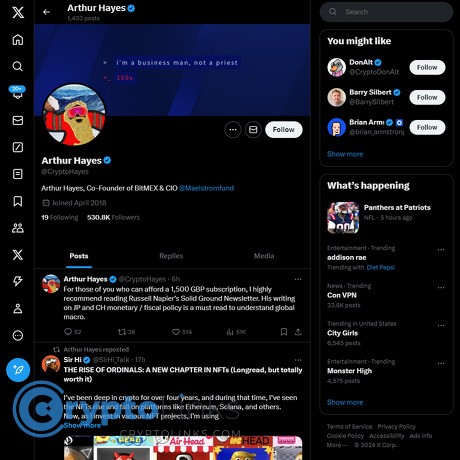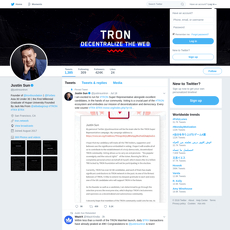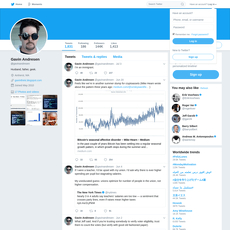Arthur Hayes Review
Arthur Hayes
x.com
Arthur Hayes X (Twitter) Review Guide: What to Expect from @CryptoHayes, His Calls, and FAQs
Is following @CryptoHayes giving you real market edge—or just more noise and FOMO? If you’ve ever read one of his threads, felt a little smarter, and still wondered what to actually do with it, you’re in the right place.
I’ve watched Hayes shape narratives and spark momentum on X for years. He’s sharp, bold, and not afraid to call big numbers. But if you treat every post as a signal, you can end up overtrading or anchoring to a take that wasn’t meant as a trade at all.
“Smart and bold—yet mixing macro think-pieces with hot takes makes it easy to misread him.”
The messy reality of following crypto on X
Crypto X is loud. The feed moves fast, and timeframes get blurred. One minute it’s a year-long macro view, the next it’s a spicy short-term take—and your brain treats both like “act now.” That confusion is expensive.
- Big claims, tiny timeframes: A sweeping macro thesis can be right over months and still wrong tomorrow. If you trade it like a signal, you’re fighting noise with leverage.
- Conflicts are real: Influential voices often hold positions. They might be right on the story and still sell into strength. That doesn’t make them bad actors—it just means you shouldn’t copy-trade strangers on the internet.
- Timeline confusion: Threads about liquidity cycles sound urgent even when the horizon is quarters or years. Your portfolio needs the right clock.
- Attention traps: Social sentiment can mark local tops. There’s research showing that attention spikes on platforms like Twitter often align with short-term reversals in crypto—great for clicks, rough for late entries. Want to see it for yourself? Check a few studies here: Twitter sentiment + crypto returns.
- Finfluencer risk is documented: Regulators keep warning about advice-like content on social platforms because people act on it without context. The FCA’s guidance is a good reality check: Financial influencers and advice.
Arthur Hayes fits this landscape perfectly: he’s influential, entertaining, and smart. But when macro essays meet quick-hit jokes, it’s easy to misread what’s a thesis vs. what’s a trade.
What I’m promising you here
I’m going to make Hayes’ content actually usable. No hype. No hero worship. Just a simple, repeatable way to read his threads, track his calls, and turn his ideas into inputs—not orders.
- Spot the patterns: What he posts most, and what that usually signals.
- Separate narrative from execution: How to avoid copy-trading while still extracting edge.
- Accuracy checks and context: Why even good calls can be dangerous if you mismatch timeframes.
- Risk-first filters: Lightweight rules I use so his hottest takes don’t hijack my plan.
Who this is for
- Traders who want macro context without sacrificing risk control.
- Investors who like bold theses but hate getting yanked around by timelines.
- Anyone trying to figure out if following @CryptoHayes adds signal—or just entertainment—to their feed.
Why this matters now
We’re in a market where liquidity, policy, and narratives can flip sentiment in hours. Hayes posts right at that intersection. Used well, his feed can help you frame the big picture and spot when the crowd is late. Used poorly, it can trick you into chasing momentum and ignoring your risk stops.
So who is Arthur Hayes, and why do people care when he tweets? That’s exactly where we’re headed next—stick with me and I’ll show you what actually makes his X account matter and how to read it without getting wrecked.
Who Arthur Hayes Is and Why People Care
Arthur Hayes isn’t just another loud account on crypto X. He’s the BitMEX co-founder who helped popularize the perpetual swap, an essayist who treats liquidity like a religion, and a macro-forward investor whose posts can tilt sentiment in minutes. When he hits send from @CryptoHayes, markets pay attention.
“Follow thinkers for the map, not the mileage.”
Background and credibility
Hayes’ edge comes from actually building and trading in the arena—not just talking about it.
- TradFi roots: He started out in equities derivatives at Deutsche Bank and Citi in Hong Kong, which shows in how he frames crypto through rates, liquidity, and balance sheet mechanics.
- BitMEX co-founder (2014): With BitMEX, he pushed the industry toward high-octane products like the perpetual swap. Whatever you think of leverage, that product reshaped crypto trading structure. BitMEX’s legacy still influences how liquidations, funding, and basis trade work today. BitMEX
- Long-form essays: He publishes detailed macro-crypto essays—part story, part playbook—on Substack and previously via the BitMEX “Crypto Trader Digest.” Expect themes like central bank liquidity, Treasury issuance, and why that matters for BTC/ETH beta.
- Active investor: He launched Maelstrom, an investment firm/family office focused on crypto opportunities across cycles. He’s not just theorizing; he’s allocating.
He’s also had real-world heat: U.S. prosecutors charged BitMEX execs over Bank Secrecy Act violations; Hayes pled guilty and received probation with home confinement in 2022. You can read the official release here: U.S. DOJ sentencing. Agree or disagree with him, that episode underscores how close he’s been to the core of crypto market structure and regulation.
Why does this history matter? Because when he talks about liquidity, funding flows, or volatility, he’s speaking from a builder-trader lens. That tends to resonate—and sometimes move markets. We’ve all seen how large accounts can shift behavior; even mainstream coverage has documented social posts jolting crypto pricing (think DOGE and celebrity tweets). Hayes operates in that same attention arena, with a macro twist.
Public profile and identity questions
People search this a lot, so here’s the straight answer: he’s African American. He’s also become a prominent public voice for crypto macro, often speaking at conferences and across media. If you want a quick overview of his career timeline, the Wikipedia profile gives the broad strokes.
Tone and style
Hayes writes and posts like a trader who thinks in liquidity regimes, not single candles. Expect:
- Macro-first framing: Central bank policy, Treasury cash balances, quantitative easing/tightening, and how they feed risk assets like BTC/ETH.
- Bold scenario maps: Big upside targets and “if-then” roadmaps, often with a long time horizon.
- Provocation with purpose: He’ll needle sacred cows—banks, fiat policy, even crypto’s own narratives—to make you interrogate your assumptions.
- Memes that carry a thesis: A joke on the timeline, then a 3,000-word essay unpacking why liquidity is the only game in town.
- Structure-aware comments: Notes on perps funding, basis, and rotations that reflect a builder’s view of market plumbing.
Real sample of how he blends these: essays like “Doom Loop”–style pieces argue that fiscal dominance and policy rescue pushes liquidity back into risk, with BTC/ETH as prime beneficiaries. On X, the shorter hits are the punchline; the essays are the scaffolding. If you’re only seeing the punchline, you might miss the framework.
Here’s the emotional undercurrent that makes his stuff sticky: he speaks to that trader instinct we all feel—“If liquidity is king, bet on the thing built for the age of liquidity.” Whether you agree or not, it’s a clean story, and markets reward clean stories in chaotic times.
So what actually shows up in your feed when @CryptoHayes posts—and how do you read it without getting spun by the noise? Let’s get practical next.
What You’ll See on @CryptoHayes (X) and How to Read It
If you follow @CryptoHayes, you’ll notice a rhythm: macro riffs, bold long-term targets, quick reactions to big market moves, and the occasional meme to puncture the tension. It’s entertaining—but the real value is knowing which posts are signal, which are mood, and how to translate each into your own plan.
"The market pays thinkers who act and punishes actors who don't think."
Content categories
Macro policy and liquidity
What it looks like: threads on the Fed, Treasury cash balances, the Reverse Repo facility (RRP), the Bank of Japan, and global liquidity flows.
How I read it: these posts frame the backdrop for risk assets. When he talks TGA/RRP or BoJ balance sheet, he’s mapping the tide, not the next wave. I check:
- RRP balance (liquidity headwinds/tailwinds): FRED RRP
- Treasury General Account (TGA): FRED TGA
- BoJ balance sheet updates: BoJ stats
Why it matters: independent market research has repeatedly shown crypto volatility clusters around macro events and liquidity shifts. For instance, Kaiko and Deribit routinely document higher implied/realized volatility around CPI and FOMC prints (Kaiko Research, Deribit Insights). His liquidity takes help you zoom out before you zoom in.
Bitcoin and ETH theses
What it looks like: long-form ideas on BTC as macro hedge or reserve collateral, ETH as a yield-bearing settlement layer, and how easing/tightening cycles filter into crypto.
How I read it: treat these as multi-quarter roadmaps. I’ll sanity-check with:
- ETF flow trackers (for BTC/ETH demand), e.g., Farside ETF flow dashboards
- Funding curves and basis to spot froth: CoinGlass
Why it matters: when he frames a structural tailwind (like liquidity easing), I don’t hit market buy; I plan entries over weeks, not hours.
Altcoin cycles and narratives
What it looks like: mentions of sectors—L2s, DeFi, RWAs, AI tokens—often tied to a “risk-on window.”
How I read it: narratives are accelerants, not engines. I look for confirmation in breadth and liquidity:
- Stablecoin net issuance (fresh ammo for alts): DefiLlama stablecoins
- Spot vs perp volumes to avoid leverage-driven traps: Kaiko terminals or exchange data
Useful note: Coin Metrics and other analytics shops have shown rotations begin in large caps, then trickle down as liquidity broadens—watch the order, don’t force it (Coin Metrics Research).
Trading psychology and risk notes
What it looks like: comments about patience, sizing, “don’t get liquidated,” or calling out overheated funding and crowded trades.
How I read it: I treat these as guardrails. When he flags froth, I’ll check:
- Perp funding extremes: Funding dashboards
- Liquidation heatmaps around key levels: Liquidation data
Personal moves and jokes
What it looks like: humor, memes, and the occasional “I bought/sold X.”
How I read it: entertainment first, information second. If it’s a personal trade post without context, I don’t mirror it—I go verify liquidity, unlocks, and on-chain flows before I decide anything.
Timing vs. direction
He’s often strong on direction over longer horizons and looser on timing. That’s not a bug; it’s the nature of macro-informed views. Here’s how I translate a post into an action plan without confusing “idea” with “entry.”
- Tag the time frame: I literally label his post in my notes as “Now,” “Soon,” or “Eventually.” Macro/liquidity = “Eventually.” Reaction to a shock = “Now/Soon.” Big structural thesis = “Eventually.”
- Use windows, not dates: if the thesis is “liquidity easing into year-end,” I’ll set a window and stagger entries. No single “all-in” day, ever.
- Confirm with the tape: on macro event days (CPI/FOMC), crypto often fakes one way before the real move. Kaiko/Deribit have documented this pattern; I wait for the second impulse, or I scale with wider stops.
- Mix approaches: DCA for the thesis, tactical trades for the noise. Two buckets, separate rules.
How I read between the lines
- If he’s talking TGA/RRP/BoJ: he’s mapping liquidity. I check those dashboards, then decide if my risk budget allows more beta exposure.
- If he posts a 10-tweet BTC/ETH thesis: I bookmark it, extract the core drivers, and set calendar reminders for the next catalysts (FOMC dates, CPI, ETF flow reviews).
- FOMC schedule: Fed calendar
- CPI release calendar: BLS CPI
- Rate expectations: CME FedWatch
- If it’s a sudden alt mention: I treat it as a prompt to research, not a buy. I’ll check
circulating vs. fully diluted supply, unlocks, treasury wallets, and depth.
- If it’s a meme or one-liner: mood check. Don’t manufacture a trade from a punchline.
How I follow
- Alerts with filters: I turn on notifications but only act on posts that contain liquidity tells (“TGA,” “RRP,” “BoJ,” “QE”), structural theses (“ETH issuance,” “collateral”), or links to long-form essays.
- Bookmark and batch: I bookmark threads and review them weekly with my notes so I don’t chase in the moment.
- Cross-check fast: one glance at funding, ETF flows, and stablecoin issuance keeps me on the right side of heat.
- Write the rule before the click: if a post tempts me into a trade, I write the thesis, invalidation level, and size first. If I can’t write it in 60 seconds, I skip it.
Signal vs. noise checklist
- High signal: multi-post macro threads, liquidity frameworks, links to essays, charts of policy balance sheets.
- Medium signal: big-picture targets without dates; useful for positioning, not entries.
- Low signal: jokes, memes, or off-the-cuff comments about niche tokens—fun, but not a plan.
I keep it simple: macro posts set the weather, BTC/ETH theses set the map, and everything else is local traffic. Want to see how those big-picture ideas turn into actual calls and where they’ve hit or missed? You’ll like what’s next—curious which predictions made headlines and how I fact-check them before risking a dollar?
Predictions: Big Calls, Sources, and What Stood Out
When Hayes posts a number with six zeros, the feed lights up. Some call it vision; others call it clickbait. I look at what he actually said, why he said it, and how you can check the receipts fast—so you’re not trading a tweet, you’re testing a thesis.
“Markets can stay irrational longer than you can stay solvent.” — John Maynard Keynes
Notable calls you’ve probably seen
Bitcoin to $1M by 2028 — He’s mapped a path to seven figures, hinging on aggressive monetary policy, persistent fiscal deficits, and liquidity injections that push investors out the risk curve. You’ll find versions of this argument across his essays and threads (macro + liquidity + scarcity), and it’s been picked up by mainstream outlets as a headline view.
Where to read more: his long-form essays on liquidity and risk cycles and broader media coverage.
BTC and ETH outperform during easing/liquidity waves — This is a recurring theme: as central banks expand balance sheets or hint at easing, he expects BTC/ETH beta to kick in. The intuition: more dollars slosh around, duration assets and high-volatility “liquidity sponges” (BTC/ETH) catch a bid.
Quick context: During 2020–2021 QE, the Fed’s balance sheet (FRED: WALCL) ballooned while BTC ripped; multiple research shops have documented crypto’s tight relationship with global liquidity (e.g., Coin Metrics SOTN and Kaiko research).
Rotations into high-beta alt sectors during risk-on windows — Expect him to talk about narratives like new L1s/L2s, DeFi perps, points farming metas, AI/compute tokens, and yes, the occasional meme mania when liquidity is loud. The playbook he implies: BTC/ETH lead, then alt sectors with narrative juice run harder for shorter bursts.
How to sanity-check: look at prior cycles’ breadth stats, dominance shifts, and sector beta during expansions (Kaiko sector dashboards, Coin Metrics factor tilts, and on-chain flows via Glassnode or CryptoQuant).
Did it play out? A quick accuracy check
I’ve seen independent community tallies floating around that graded a batch of ~20 of his market calls: 16 marked as misses, 2 as hits, and 2 still pending at the time they were compiled. Take that for what it is—a snapshot, not gospel—but the takeaway is useful: bold, long-horizon theses are tough to convert into short-term trades.
Two common pitfalls I see followers fall into:
- Direction vs. timing: He can be right on the narrative while months early (or late) on the move. If you trade the timestamp, not the thesis, your PnL can disagree with the eventual outcome.
- Anchor risk: Slapping a price target on your brain (“$1M or bust”) makes you ignore changing liquidity, positioning, or policy signals. Targets are stories; trades are risk units plus entries/exits.
How I use these predictions (so they actually help)
- Treat them as narrative scaffolding: I’ll jot the thesis in a note (policy path → liquidity → crypto beta) and then build my own triggers: moving averages, funding flips, breadth, or simple time-based scaling.
- Separate cycles: If the call is multi-year, I won’t force a weekly trade. I’ll position core exposure for the thesis and keep a smaller stack for tactical swings.
- Position sizing over bravado: The bigger the target, the smaller my initial size. If the path unfolds (policy -> liquidity -> flows), I scale.
- Use brackets, not anchors: Instead of “$1M,” I keep ranges and scenarios. If liquidity stalls or policy tightens, I shift to defense without ego.
Fact-check toolkit while you scroll X
- Liquidity gauges: Fed balance sheet (FRED WALCL), global M2 trackers, and central bank announcements calendars.
- Policy odds: CME FedWatch for rate odds, plus CPI/PCE release dates via the BLS calendar.
- Market structure + flows: Coin Metrics SOTN, Kaiko, Glassnode.
- Price + dominance context: BTC.D and ETH BTC pairs on your charting platform; confirm when alt beta is statistically “on.”
- Back-of-the-envelope sanity: If a target implies a market cap that dwarfs plausible liquidity growth within the stated time, I tag it as a story, not a schedule.
If you’re wondering how these bold calls line up with his own trading—and what happens when enthusiasm meets a sell button—you’ll want to see what comes next. Ever caught a token he praised and then watched it dump on “profit-taking”? Let’s talk about that.
Controversies, Conflicts, and “Skin in the Game”
When a market mover shares positions in real-time, it feels like a shortcut. It isn’t. Hayes trades. He takes profits. He changes his mind. That’s not a flaw—it’s how pros survive. The conflict shows up when people mirror him without context and get caught holding the bag.
“Never confuse someone else’s conviction with your own risk tolerance.”
I’ve watched this play out in countless mini-cycles: a sharp thesis lands, liquidity rushes in, price runs, then the exit window is a few candles wide. If you’re the last buyer, you end up paying for someone else’s discipline.
Recent example people ask about
One widely circulated case: Hayes reportedly sold a chunk of HYPE tokens after a profitable run—then joked it helped fund a Ferrari deposit. He’s known for tongue-in-cheek posts, so the humor landed. But if you bought after his early enthusiasm and didn’t have a plan, that joke stung.
I’m not here to litigate the timing of every entry/exit or authenticate every screenshot; X moves fast and narratives move faster. What matters is the pattern:
- Narrative vs. execution: A smart story brings attention. Execution—the boring part—decides P&L.
- Liquidity gap: Thin books can handle early buys but not late exits. Price slips hard when crowd exits together.
- Time preference mismatch: His time horizon may be hours or days. Yours might be weeks. That mismatch is expensive.
There’s nothing wrong with taking profits. In fact, it’s the point. The frictions show up when followers treat a thread like a binding contract instead of a high-level opinion from someone who actively manages risk.
What this means for you
- Assume he’s flat-out active: He’ll buy, sell, hedge, and rebalance around the same narrative. Expect changes.
- Assume he sells into strength: That’s not “dumping on followers.” That’s trading a move he helped spotlight.
- Assume you’ll be late: If your fill comes minutes after a viral post, you’re stepping onto a moving walkway.
- Don’t copy-trade: You don’t know his size, hedges, or stop. Build your own rules or sit it out.
To keep this grounded, here’s what the data says about attention-driven moves. Academic and industry work consistently shows social buzz can spark short-term returns and volume—but it also increases volatility and reversal risk:
- SSRN: How Elon Musk’s Twitter Activity Moves Cryptocurrency Markets – significant abnormal returns and volume after high-profile tweets.
- MDPI: Twitter Sentiment and Bitcoin Returns – sentiment can predict short-term moves, with fast decay.
- SSRN: Cryptocurrency Pump-and-Dump Schemes – organized attention spikes often end with sharp reversals as liquidity thins.
Translation: attention is a catalyst, not a parachute.
Red flags to watch
- Sudden token spotlights: If a new ticker shows up in a high-engagement thread, expect a fast liquidity shock. Decide before the post whether you trade that playbook.
- Thin-liquidity names: Check real liquidity, not just FDV. Use DexScreener or your DEX of choice to see depth, spreads, and slippage at your size.
- Unlock calendars: Posts that rhyme with unlocks or emissions schedules deserve extra skepticism. Verify on TokenUnlocks or CoinGecko tabs for supply changes.
- Wallet flow theater: If a wallet is publicly attributed, corroborate with multiple sources before assuming anything. Tools like Etherscan and labels on Arkham can help—but labels are not guarantees.
- High FDV, low float: Classic recipe for a brutal round-trip. Great for narratives, unforgiving for late entries.
- Perpetual funding shifts: After a viral post, funding often spikes. If you’re long into rich funding, you’re paying to hold into potential chop. Track it on your preferred derivatives dashboard.
“Skin in the game” cuts both ways
To his credit, Hayes often signals when he’s taking profits or changing posture. That transparency can be helpful—if you remember he’s trading a book, not babysitting your entry. It’s also why you’ll sometimes see a bullish thesis alongside a tactical sell. Both can be true: the narrative is intact, the trade is done.
Two simple rules I keep taped to my monitor whenever a big account posts a “banger”:
- Strong views, small size until proven right: Start with a nibble. Let price and liquidity confirm before you scale.
- Assume exit risk: Always pre-plan your exit if the crowd turns. If you can’t write it down in one line, you don’t have it.
It’s easy to romanticize “skin in the game” when the line goes up. It’s harder to remember that skin burns on the way down, and the only skin that matters is yours.
So how do you extract the signal from his posts without getting trapped by these frictions? In the next section I share the exact playbook I use—simple checks, timing cues, and a way to turn viral threads into clean, risk-defined trades. Want the checklist?
Getting Real Value from Hayes’ Content (Without Getting Wrecked)
I like Hayes because he’s original and macro-first. But I never smash market buys after a spicy thread. Here’s how I squeeze signal from his posts while keeping my PnL intact.
A practical playbook
- Separate narrative from trade. I write the thesis in one line (“liquidity easing favors BTC/ETH risk-on”), then build my own setup. Example: wait for a pullback to a prior weekly level, or for funding to reset after a heated move.
- Timeframe check. Is he talking in quarters/years or days/weeks? I mark it as LT (months+), MT (weeks), or ST (days). I won’t use an LT idea to justify a same-day scalp.
- Risk first. Before I touch “buy,” I define max loss. My default: risk 0.5–1.5% of account per idea, stop where the thesis is wrong (not where it “feels” right). If position size looks silly after slippage/fees, I pass.
- Cross-verify in 10 minutes. I check macro calendars (FOMC, CPI, NFP), on-chain flows (exchange reserves, stablecoin netflows), and perp metrics (funding, open interest, basis). If two of those disagree with the post, I wait.
Case study: turning a thread into a plan
Scenario: He frames a coming liquidity impulse and strong BTC/ETH tailwind into the next quarter.
- Narrative: Easing liquidity = higher beta returns in majors first, alts later.
- Trigger: Watch real-world events (e.g., dovish FOMC, TGA drawdowns, balance sheet shifts) and market tells (BTC dominance stalling + breadth expanding).
- Setup: For BTC/ETH, I prefer breakdown-reclaim patterns on the daily. Example: if ETH reclaims a weekly level on rising spot volume while funding cools, I scale in 3 tranches.
- Invalidation: Close if D1 structure breaks and funding remains elevated (crowded longs) or if the macro catalyst flips (hawkish surprise).
- Execution: No market chasing after the post. I place limit bids at prior value areas and let the trade come to me.
Timing windows I actually use
- Pre-event drift: If the post references a known event (CPI/FOMC), I assume a “drift” 3–10 days prior. I position small, add only if data agrees.
- Post-event 24–72h: Volatility whipsaws right after. I often wait a day for direction to stick unless my plan was to fade the first move.
- Narrative maturation: For LT theses, I set quarterly checkpoints. If liquidity metrics don’t improve by then, I de-risk even if price is up.
Risk guardrails that saved me
- Max 1–2% account risk per thesis, split across entries. This echoes what position-sizing research and the Kelly framework have long suggested: underbetting beats overbetting when edge and variance are uncertain.
- Skip thin-liquidity chases. Studies on crypto pump-and-dumps show coordinated surges often happen in illiquid tokens; that’s where retail gets clipped after influencers spotlight them. If depth is shallow or slippage >0.5% on my size, I pass.
- Attention filter. Classic research (Barber & Odean) shows attention-driven trading hurts returns. When a Hayes post sends a ticker trending, I assume worse fills and faster reversals—so I wait for a clean retest or skip.
- No “all-in” on narratives. Social mood can front-run and then reverse price. I’ll scale out into strength and keep a runner only if the macro data keeps confirming.
Cross-verification shortcuts
- Macro: FOMC/CPI/NFP calendar, UST curve (2s/10s), DXY trend, liquidity gauges (TGA, RRP direction).
- On-chain: Exchange reserves for BTC/ETH, stablecoin net issuance/flows, miner balance trends.
- Perps: Funding rate spikes, open interest jumps without spot confirmation, basis (carry) widening.
- Market breadth: BTC.D, ETH/BTC ratio, % of top 100 alts making higher highs. Broadening = healthier risk-on.
My Hayes tracker note (simple template)
- Date + link: When and where he posted.
- Thesis: One sentence in my own words.
- Timeframe: ST / MT / LT.
- Proof points: 2–3 data checks I’ll monitor.
- Plan: Entries, invalidation, size, targets.
- Outcome: Win/loss + what I’d change next time.
After a month of logging, you’ll notice patterns: which of his themes you actually trade well, where you get early/late, and which signals deserve alerts.
Alert setup that actually helps
- Turn on X alerts for his account, but mute replies. I want the source, not the noise.
- Tag and archive: I bookmark long-form posts and tag them “LT thesis.” The quick memes get a pass unless they point to a real setup.
- Add macro alerts: CPI/FOMC dates, DXY level breaks, liquidity shifts. If a Hayes post aligns with these, it’s higher priority.
What I ignore (on purpose)
- Single number price targets without a path. Great for headlines, weak for entries.
- Illiquid token spotlights right before unlocks or exchange listings. Research on crypto pump cycles shows these windows are where retail eats the worst fills.
- Hot takes during peak volatility. I screenshot, breathe, and revisit once the 1-hour candle closes. Saves me more than it costs me.
Resources I recommend
If you want supporting material and tools I trust, check these:
Pro tip: make the narrative tradable
I use a simple “Rule of 3” before I act on any post:
- Narrative: Can I explain the idea in one sentence?
- Data: Do at least two independent metrics back it up?
- Risk: Do I have a clean invalidation and sane size?
If any box is empty, I don’t trade it. It’s amazing how much FOMO disappears when you hold yourself to those three checks.
Quick stat: Retail investors tend to overtrade after attention spikes and underperform; keeping a checklist cuts the knee-jerk actions. Your edge is patience and process, not speed.
Want the fast answers everyone asks—accuracy, best way to follow, and how I think about his big targets? Keep going to the FAQ next—what’s the one stat I look at before giving any market call real weight?
FAQ: Arthur Hayes—Answers to What Everyone Asks
What are Arthur Hayes’ predictions for crypto?
He’s painted some big upside paths for Bitcoin—as high as $1M by 2028—driven by loose monetary policy, liquidity waves, and fiscal deficits that push investors into scarce, risk-on assets. He often frames BTC and ETH as the cleanest beneficiaries when central banks go soft and money sloshes back into markets. If you want his long-form reasoning, check his essays on Substack and real-time takes on X.
How I use it: I treat these as macro narratives, not precise trade signals. Big targets help me think about cycles, but my entries, exits, and size come from my own system.
How accurate is he?
Directionally, he’s solid on long-run ideas, but timing can be tough. An independent tally (circulated widely in crypto circles) reviewed 20 market calls and counted 16 misses, 2 hits, and 2 pending at the time. That sounds harsh, but it matches the reality of macro-driven calls: they’re useful framing tools—just hard to trade day to day.
Quick sanity check: social posts can move crypto in the short run, but they also increase noise. Research backs that:
- Finance Research Letters (2021) found that high-profile tweets can impact crypto returns and volume.
- SSRN studies on Bitcoin sentiment show social chatter affects volatility and short-term price action.
Bottom line: treat Hayes’ calls as a map, not a GPS. Timing is on you.
Did he sell crypto (like HYPE)?
Yes. He publicly took profits on HYPE and even joked it helped fund a Ferrari deposit. That stung for late buyers who assumed he’d hold longer.
Takeaway: he trades. Assume active position management, partial profit-taking, hedges, and changing risk. If you mirror trades without context, you’re guessing. Build your own rules.
Is Arthur Hayes black or white?
He’s African American. This shows up in search queries more than you’d think, so here’s the straight answer.
What’s the best way to follow him without getting whipsawed?
- Follow @CryptoHayes and use Lists so his posts sit next to macro and on-chain sources you trust.
- Bookmark long threads and essays, then translate the thesis into your own trade plan.
- Set alerts for high-impact events he talks about (CPI, FOMC, Treasury refunding, liquidity updates) and cross-check with your calendar.
- Size small first when a fresh narrative appears. Add only if your setup confirms, not because a post is viral.
Does he disclose positions?
Sometimes, and often after the fact. He’ll talk about his books and moves, but not in a way you can reliably copy. Assume there’s nuance—options, hedges, multiple accounts, and different timeframes. That’s normal for pros.
Can his posts move markets?
For majors like BTC and ETH, the market is deep; posts can nudge sentiment but rarely set trend on their own. For thin-liquidity tokens, attention can absolutely swing price. That’s why I always check float, unlocks, and depth before touching anything he highlights.
How do I use his ideas without overtrading?
- Separate narrative from trade: write the thesis in one line, then wait for your setup (levels, risk, and invalidation).
- Timeframe filter: if the idea is multi-quarter, don’t FOMO into a 5-minute candle.
- Risk first: predefine max loss. No thesis is worth a blown account.
- Cross-verify: match his claims with liquidity metrics, macro calendars, and on-chain flows before acting.
Final word
My take: follow Hayes for macro framing and market structure—the stuff that actually helps you think. He’s sharp and often entertaining, but he’s not your financial advisor. Use his posts as inputs, not orders. If you want more no-nonsense breakdowns like this, check the latest on cryptolinks.com. I’ll keep tracking the voices that genuinely help you trade better.
CryptoLinks.com does not endorse, promote, or associate with Twitter accounts that offer or imply unrealistic returns through potentially unethical practices. Our mission remains to guide the community toward safe, informed, and ethical participation in the cryptocurrency space. We urge our readers and the wider crypto community to remain vigilant, to conduct thorough research, and to always consider the broader implications of their investment choices.













